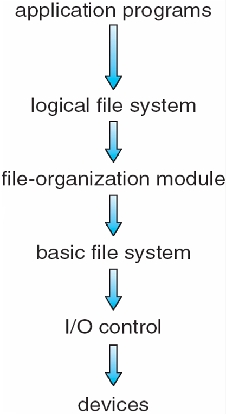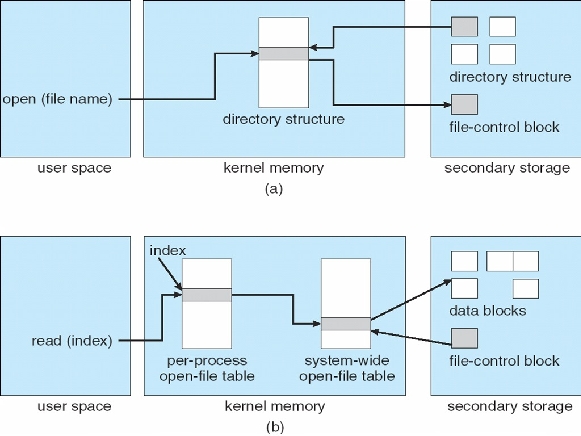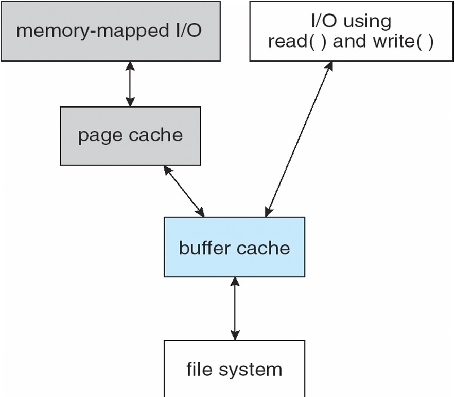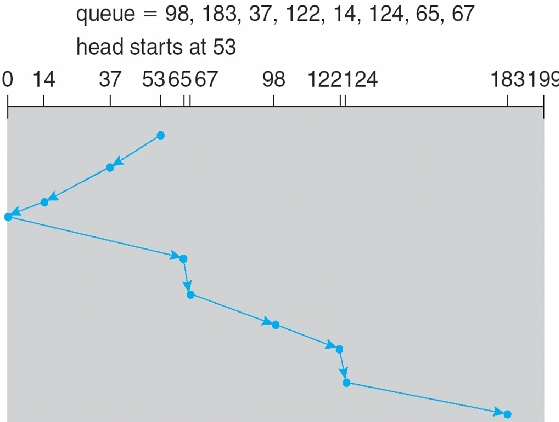
- •I/o Bound: spends more time doing I/o than computations, many short cpu bursts
- •Issues include: thread cancellation, signal handling (synchronous/asynchronous), handling thread-specific data, and scheduler activations.
- •Void Swap (boolean *a, boolean *b){
- •Internal Fragmentation: allocated memory may be slightly larger than requested memory
- •Valid and invalid bits can be used to protect memory
- •Volume contains file system: also tracks file system's info in device directory or volume table of contents
- •In a file sharing system User iDs and Group iDs help identify a user's permissions
- •Increase efficiency by grouping blocks into clusters - Disk I/o is performed on blocks
- •I/o is a major factor in system performance – demand on cpu, context switching, data copying, network traffic
Volume contains file system: also tracks file system's info in device directory or volume table of contents
File system can be general or special-purpose. Some special purpose FS:
tmpfs – temporary file system in volatile memory
objfs – virtual file system that gives debuggers access to kernel symbols
ctfs – virtual file system that maintains info to manage which processes start when system boots
lofs – loop back file system allows one file system to be accessed in place of another
procfs – virtual file system that presents information on all processes as a file system
Directory is similar to symbol table – translating file names into their directory entries
Should be efficient, convenient to users, logical grouping
Tree structured is most popular – allows for grouping
Commands for manipulating: remove – rm<file-name> ; make new sub directory - mkdir<dir-name>
Current directory: default location for activities – can also specify a path to perform activities in
Acyclic-graph directories adds ability to directly share directories between users
Acyclic can be guaranteed by: only allowing shared files, not shared sub directories; garbage collection; mechanism to check whether new links are OK
File system must be mounted before it can be accessed – kernel data structure keeps track of mount points
In a file sharing system User iDs and Group iDs help identify a user's permissions
Client-server allows multiple clients to mount remote file systems from servers – NFS (UNIX), CIFS (Windows)
Consistency semantics specify how multiple users are to access a shared file simultaneously – similar to synchronization algorithms from Ch.7
One way of protection is Controlled Access: when file created, determine r/w/x access for users/groups
Ch.11 – File System Implementation
File system resides on secondary storage – disks; file →system is organized into layers
File control block: storage structure consisting of information about a file (exist per-file)
Device driver: controls the physical device; manage I/O devices
File organization module: understands files, logical addresses, and physical blocks
◦ Translates logical block number to physical block number
◦ Manages free space, disk allocation
Logical file system: manages metadata information – maintains file control blocks
Boot control block: contains info needed by system to boot OS from volume
Volume control block: contains volume details; ex: total # blocks, # free blocks, block size, free block pointers
Root partition: contains OS; mounted at boot time
For all partitions, system is consistency checked at mount time
◦ Check metadata for correctness – only allow mount to occur if so
Virtual file systems provide object-oriented way of implementing file systems
Directories can be implemented as Linear Lists or Hash Tables
◦ Linear list of file names with pointer to data blocks – simple but slow
◦ Hash table – linear list with hash data structure – decreased search time
▪ Good if entries are fixed size
▪ Collisions can occur in hash tables when two file names hash to same
location
(a) open()
(b) read()
Contiguous allocation: each file occupies set of contiguous blocks


Simple, best performance in most cases; problem – finding space for file, external fragmentation
Extent based file systems are modified contiguous allocation schemes – extent is allocated for file allocation
Linked Allocation: each file is a linked list of blocks – no external fragmentation
Locating a block can take many I/Os and disk seeks
Indexed Allocation: each file has its own index block(s) of pointers to its data blocks
Need index table; can be random access; dynamic access without external fragmentation but has overhead
Best methods: linked good for sequential, not random; contiguous good for sequential and random
File system maintains free-space list to track available blocks/clusters
Bit vector or bit map (n blocks):→(#bits/word)*(#blocknumbercalculation0
-value words)+(offset for 1st bit)
◦
Example:
block size = 4KB = 212 bytes
disk size = 240 bytes (1 terabyte)
n = 240/212 = 228 bits (or 256 MB)
if clusters of 4 blocks -> 64MB of memory
 S
S pace
maps (used in ZFS) divide device space into metaslab
units and manages metaslabs ◦
Each metaslab has associated space map
pace
maps (used in ZFS) divide device space into metaslab
units and manages metaslabs ◦
Each metaslab has associated space map
Buffer cache – separate section of main memory for frequently used blocks
Synchronous writes sometimes requested by apps or needed by OS – no buffering
Asynchronous writes are more common, buffer-able, faster
Free-behind and read-ahead techniques to optimize sequential access
Page cache caches pages rather than disk blocks using virtual memory techniques and addresses
Memory mapped I/O uses page cache while routine I/O through file system uses buffer (disk) cache
Unified buffer cache: uses same page cache to cache both memory-mapped pages and ordinary file system I/O to avoid double caching
Ch.12 – Mass-Storage Systems
Magnetic disks provide bulk of secondary storage – rotate at 60 to 250 times per second
Transfer rate: rate at which data flows between drive and computer
Positioning time (random-access time) is time to move disk arm to desired cylinder (seek time) and time for desired sector to rotate under the disk head (rotational latency)
Head crash: disk head making contact with disk surface
Drive attached to computer's I/O bus – EIDE, ATA, SATA, USB, etc.
Host controller uses bus to talk to disk controller
Access latency = Average access time = average seek time + average latency (fast ~5ms, slow ~14.5ms)
Average I/O time = avg. access time + (amount to transfer / transfer rate) + controller overhead
Ex: to transfer a 4KB block on a 7200 RPM disk with a 5ms average seek time, 1Gb/sec transfer rate with a
.1ms controller overhead = 5ms + 4.17ms + 4KB / 1Gb/sec + 0.1ms = 9.27ms + .12ms = 9.39ms
Disk drives addressed as 1-dimensional arrays of logical blocks
1-dimensional array is mapped into the sectors of the disk sequentially
Host-attached storage accessed through I/O ports talking to I/O buses
Storage area network (SAN): many hosts attach to many storage units, common in large storage environments
Storage made available via LUN masking from specific arrays to specific servers
Network attached storage (NAS): storage made available over a network rather than local connection
In disk scheduling, want to minimize seek time; Seek time is proportional to seek distance
Bandwidth is (total number of bytes transferred) / (total time between first request and completion of last transfer)
Sources of disk I/O requests: OS, system processes, user processes
OS maintains queue of requests, per disk or device
Several algorithms exist to schedule the servicing of disk I/O requests
FCFS, SSTF (shortest seek time first), SCAN, CSCAN, LOOK, CLOOK
SCAN/elevator: arm starts at one end and moves towards other end servicing requests as it goes, then reverses direction
CSCAN: instead of reversing direction, immediately goes back to beginning
LOOK/CLOOK: Arm only goes as far as the last request in each directions, then reverses immediately
 Low
level/physical formatting:
dividing a disk into sectors that the disk controller can
Low
level/physical formatting:
dividing a disk into sectors that the disk controller can
SCAN
read and write – usually 512 bytes of data
Partition: divide disk into one or more groups of cylinders, each treated as logical disk
Logical formatting: “making a file system”
